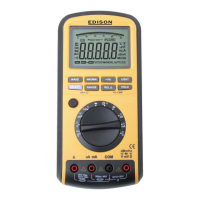3
High Accuracy Digital Multimeter with USB Interface
During use
• Use EXTREME CAUTION when working around bare conductors or bus bars.
• DO NOT operate the meter around explosive gas, vapour, or dust.
• The meter MUST NOT BE USED in an environment with combustible gases,
steam or dust pollution.
• You should be careful when measuring voltages higher than 30V AC (effective
value) or 50V DC, such voltage levels carry a risk of high shocks. Avoid the
body directly touching ground or any metal substance in which there may be
ground potential during measuring. The body should be kept insulated from
the ground with dry insulated shoes, insulating pads or insulating clothes.
• You MUST NOT try to measure a voltage higher than 1000V AC or 1000V DC,
the meter may be damaged and the operators safety may be threatened if the
limit for voltage measurement be exceeded.
• Verify a meters operation by measuring a known voltage and DO NOT use the
meter if it operates abnormally. Protection may be impaired. When in doubt,
have the meter serviced.
• Use the proper terminals, function, and range for your measurements.
• When the value scale to be measured is unknown beforehand, ALWAYS set the
range dial at the highest position.
• NEVER exceed the protection limit values indicated in the specifications for
each range of measurement.
• DO NOT touch unused terminals when meter is linked to a circuit.
• Be careful when working with voltages above 60V DC or 30V AC rms.
• When using the probes, keep your fingers behind the finger guards.
• WHEN CONNECTING - connect the common test lead before connecting the
live test lead. WHEN DISCONNECTING - disconnect the live test lead before
disconnecting the common test lead.
• Before changing functions, disconnect the test leads from the circuit under test.
• For all DC functions, including manual or auto range, to avoid the risk of shock
due to possible improper reading, verify the presence of any AC voltages by
first using the AC function. Then select a DC voltage range equal to or greater
than the AC range.
• Disconnect circuit power and discharge all high-voltage capacitors before
testing Resistance, Continuity, Diodes, or Capacitance.
• NEVER perform resistance or continuity measurements on live circuits.
• Before measuring current, check the meters fuse and turn off power to the
circuit before connecting the meter to the circuit.

